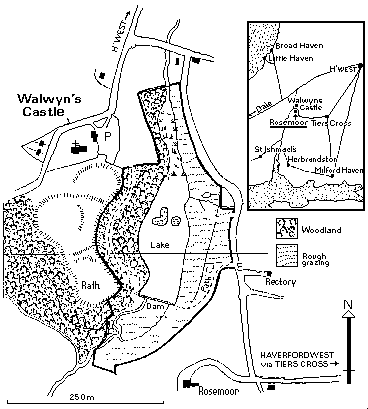Rose Cottage (Sleeps 2)
Rose Cottage - our baby - is the smallest of our cottages; sleeping two. In any other sense Rose is anything but small: it…
Many thanks, lovely accommodation. Will bear it in mind for another time.
Mash Family
Apple Cottage
Rosemoor's present day grounds cover some 35 acres (14 hectares). Of these, some 25 acres have been dedicated as a Nature Reserve in Wales. Through the valley in which the Reserve lies and over which Rosemoor looks out, a small stream flows to the sea, discharging itself through Sandyhaven Pill into the Milford Haven estuary. With the help of a grant from the Nature Conservancy Council this stream was dammed, creating a 5½-acre lake which now forms the heart of the Reserve.
In 2012 we commissioned local artist Robert Jakes to design and carve three stunning oak benches that were placed in various locations by the side of the lake. Subject matter for their decoration is taken directly from the surrounding nature: Kingfisher, Otter and Dragonfly.
In 2015 our neighbour and friend Wayne made a fourth bench which was put along the path that leads up the hill towards the church on the western side of the Reserve: made with left-over concrete from a newly laid floor for the uprights, and pitch pine timbers for the seat, made from old roofing timbers of one of the cottages in the courtyard at Rosemoor a perfect example of upcycling. From the high vantage point this bench offers one has lovely views of the breeding islands in Rosemoor lake.
Our friend Bram Hengeveld shot two lovely videos and posted them on YouTube. One shows his little steamboat on the lake and the other one lets you just sit and listen. Experience the beauty and the quiet by watching them!

The Nature Reserve lies just to the south-east of a steep wooded slope across the valley, composed of Silurian shales, which now forms the western edge of the Lake. At that point the eastern bank of the stream was sloping very gradually, so that now the Lake is very shallow over a considerable distance on that side. On the western side it is much deeper. This combination makes the Lake an ideal place for a great variety of wildlife.
Upon flooding former hillocks in the valley were completely surrounded by water, forming refuge islands for birds to breed. The vegetation of the valley was drowned when it was flooded; the remains of trees can still be seen standing in the Lake in one of the photographs on this page.
In the Nature Reserve paths have been created which form part of the National Park network, linking inland areas to the coast. In various places tiny streams flow into the Lake from the eastern side. In recent years our National Park Ranger and her loyal band of volunteers have put in a lot of effort to improve this part of the paths network.
Part of this effort was directed at facilitating access for those with mobility problems. With a considerable quantity of clean hardcore from one of our major renovation projects and subsequent dressing and compacting with fine stone we were able to have the path leading from the lowermost gate into the Reserve to one of the benches by the lakeside made accessible to wheelchair users and those who generally need a firm walking surface.
The Rosemoor Nature Reserve South Wales, is inhabited by badgers (at least 2 setts are situated within the grounds), otters (difficult to see, except for their spraint which is a telltale sign of their presence) and a great variety of birds. Mallard, coot and moorhen are to be found, as are the Canada Geese, who return every year to produce their delightful fluffy yellow goslings on the islands in the Lake. Heron, cormorant, lesser black backed gulls are regular visitors, as are little grebe, pochard, golden-eye and tufted ducks. The lovely blue of a kingfisher is frequently seen as well.
Since early 2007 a pair of mute swans are in residence on the lake and have successfully raised cygnets.
Peregrine falcons have been seen breeding within sight of Rosemoor, and if you are lucky merlins can be seen hunting for prey.
In the Reserve, in the fields surrounding us and close to our house as well we very frequently see pheasants (possibly escaped from a nearby farm, but happy enough to live in the wild, or so it seems), rabbits and the more common types of birds: magpies, jackdaws, house sparrows (lots!), jays, wrens, robins, tits, woodpeckers, swallows, et cetera.
More common birds of prey - notably owls and buzzards - live off the small animals literally walking onto their dinner plates; perched on a nearby telephone pole, all they have to do is wait.
The Reserve is a botanist's delight: Tommy Warren-Davies, one of the foremost Welsh naturalists, and John Comont were the first wardens of the Reserve and in it they catalogued nearly 200 different species of flora, including a handful of rare plants.
Part of the Reserve is kept as a meadow. In the spring of 2007 this part of the Reserve was fenced and new gates were put in. This allows us to have a pair of Welsh ponies for part of the year (in an arrangement with the Pembrokeshire Coast National Park); to our benefit and that of nature, as the open meadowland is attractive to various butterflies and small songbirds.
Grazing keeps the blackthorn from taking over. In other parts of the reserve the blackthorn has to be removed periodically by man.